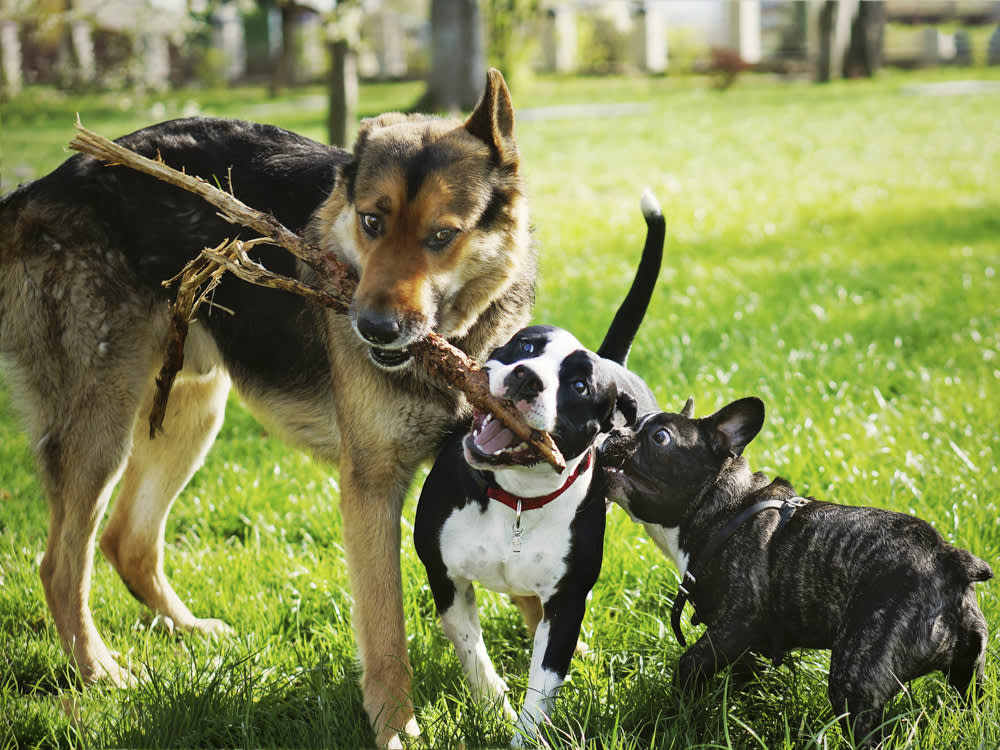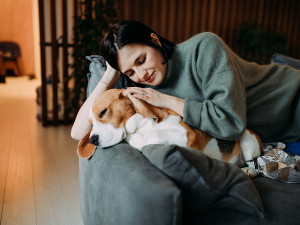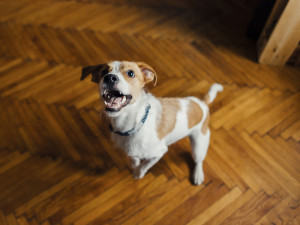Some Like It Rough: Playing vs Fighting
Two animal behaviour experts agree that it’s usually play fighting. Here’s how you can tell
As animal behaviour researchers, we have been studying dog play for more than 10 years. Together with our colleagues, we have analysed hundreds of hours of data to test hypotheses about play. We present our results at animal behaviour conferences and publish in scientific journals. One thing we’ve found: dog play that some might consider ‘inappropriate’ or ‘unsafe’ is actually just play fighting.
What is dog play fighting?
In the field of animal behaviour, researchers often refer to social play as ‘dog play fighting’ because it includes many of the behaviours seen during real fights and might look rougher than it really is. For example, during play, one dog might chase and tackle another, or use a neck bite to force a partner to the ground. Dogs will also hip check or slam, mount, rear up, bite, stand over, sit on, bark, snarl, growl, bare their teeth and do chin-overs (ie, place the underside of their chin over the neck of their partner).
Get (totally free) deals for food, treats, accessories, tech and way more pet parenting must-haves.
However, despite the overlap in behaviours, some clear differences exist between dog play fighting and real fighting. When dogs are playing, they inhibit the force of their bites and sometimes voluntarily give their partner a competitive advantage (self-handicap) by, for example, rolling on their backs or letting themselves be caught during a chase – behaviours that would never happen during real fighting.
In addition to inhibited bites and self handicapping, dogs clearly demarcate play by employing signals, such as play bows (ie, putting the front half of the body on the ground while keeping the rear half up in the air) and exaggerated, bouncy movements.
Anthropologist Gregory Bateson called play signals meta-communication, meaning communication about communication. Humans employ meta-communication a lot. For example, when teasing a friend, we may smile or use a certain tone of voice to indicate that we’re just kidding. Similarly, dogs play bow to invite play and to convey playful intentions during play.
Marc Bekoff, while at the University of Colorado, did a study showing that dogs are most likely to play bow just before or immediately after performing an especially assertive behaviour, such as a bite accompanied by a head shake. This pattern suggests that playing dogs recognise moments when their behaviour can be misinterpreted as serious aggression and compensate by reminding their partner, “I’m still playing.”
By using meta-communication, social beings can step through a looking glass into a world that operates by different rules. Meta-communication allows humans and dogs to pretend – that is, to perform actions that appear to be one thing but actually mean something completely different. To people unfamiliar with the notion that some nonhuman animals have this ability, play that includes archetypal aggressive behaviours, like snarling and growling, can be quite confusing. Close attention to the context, however, can help us differentiate between play aggression and real aggression.
Even though play fighting is very different from real fighting, people often feel the need to intervene. Sometimes it is obvious at the beginning of a bout that two dogs are playing, but once the dogs start growling or their arousal intensifies, observers may no longer be sure that the dogs are still playing. After all, humans instinctively avoid a dog who is snarling or baring his teeth, and it is natural to think that our dogs should do the same. When people interrupt really rowdy play, they assume that they are ‘playing it safe’ and doing no harm. But what if this assumption is mistaken?
Our research shows that for many dogs, play fighting is the primary method used to negotiate new relationships and develop lasting friendships. Although play is fun, it also offers serious opportunities to communicate with another dog. In this sense, play is a kind of language. Thus, when we regularly break up what we consider ‘inappropriate’ play, are we doing our dogs a service, or confusing them by constantly butting into their private conversations? Most importantly, how can we tell the difference?
How to tell if a dog is playing or fighting
First, we need to determine whether both dogs are enjoying themselves and want to continue playing. Look at their postures and facial expressions. The dog’s movements may be light, bouncy and exaggerated, and they may have relaxed open mouths. Watch for play signals, which can often be quite subtle – a quick dip or bounce rather than a full-blown play bow.
If you’re not certain that a dog really wants to be playing, try briefly holding that dog back. If they press their body into yours and avoid looking at the other dog, they’re showing relief at the interruption and you should help them avoid the other dog. If they pull against your grip in an attempt to interact with the other dog, release them. If they run towards the other dog or send a play signal in their direction, then they’re saying that they want to keep playing.
An interaction like the one just described is straightforward and easy to read. However, what about instances that may not be so clear-cut? We encourage you to discard any preconceived notions about what dog play should and should not look like – at least for the time being. For example, are acts like neck biting, rearing up, body-slamming and repeated pinning by one dog ever OK when two dogs are playing? Yes. What is safe dog play? Appropriate dog play fighting all depends on the individual dogs and the kind of relationship they have with one another.
Unorthodox dog play: when some dogs like it rough
Consider an example of a close canine friendship founded on unorthodox play. When Sage, a one-year-old German Shepherd, first met Sam, a four-month-old Labradoodle, he was very rough with Sam. He would pin Sam with a neck bite every few seconds. No sooner would Sam stand up than Sage would neck bite him and flip him on his back again.
At first, we thought that Sage might be too rough for Sam, so we would intervene by holding one or both of them back. However, each time, Sam would try his hardest to get to Sage, despite the inevitable pinning. As Sam grew larger, eventually matching Sage in weight, Sage added body slams and mounting to their play. With the exception of frequent rear-ups (in which they adopted identical roles, facing one another and boxing with their front paws), Sage usually maintained the more assertive role (neck biting, pinning, slamming and so forth). Yet, because Sam was always an enthusiastic partner, we let them continue to play together.
To this day, their play remains asymmetrical; Sage repeatedly brings down Sam with neck bites and continues to bite Sam’s neck once he is down. Sam wriggles on the ground and flails at Sage with his legs, while Sage, growling loudly, keeps biting Sam’s neck. More than once, bystanders have thought the dogs were fighting for real, but Sage’s neck bites never harm Sam, and Sam never stops smiling, even when he’s down. Sometimes, when Sage is done playing but Sam is not, he’ll approach Sage and offer his neck, as though saying, “Here’s my neck; go ahead and pin me.” This move always succeeds; it’s an offer Sage cannot resist.
With Sage and Sam, allowing play to continue was the right decision. Their early play interactions burgeoned into a lifelong friendship. Even today, the two middle-aged boys will sometimes play together for five hours at a stretch, stopping only occasionally for brief rests. When they are finally done, they often lie together, completely relaxed, with their bodies touching. Their faces are loose and smiling, and they seem almost drunk in an endorphin-induced haze.
This relationship shows that play does not necessarily have to be fair or balanced in order for two dogs to want to play with one another. Years ago, scientists proposed a 50/50 rule: for two individuals to engage in play, they must take turns being in the more assertive role. Scientists thought that if one dog was too rough or forceful (pinning their partner much more often than they were being pinned), the other dog would not want to play. Until our research, this proposition was never empirically tested.
Over a 10-year period, we studied pairwise play between adult dogs, between adult dogs and adolescents, and between puppy littermates. Our findings showed that the 50/50 rule simply did not apply. Dogs do not need to take turns being assertive in order for play to take place. However, this doesn’t mean that dogs never role-reverse during play, because they often do. It just means that role reversals usually aren’t equally balanced.
Growling during dog play
Safi, a female German Shepherd, and Osa, a male Golden Retriever mix, were best friends for many years. When they played, they snarled a lot, lips curled and teeth exposed. The snarls looked fierce, but they often preceded silly behaviours, like flopping on the ground. Also, when something in the environment suddenly interrupted their play, the dogs’ faces would instantly shift into neutral, alert expressions while they focused on whatever had stolen their attention.
Then, as though on cue, Safi and Osa would put their scary faces back on, almost as if they were Halloween masks, and turn towards one another. Their expressions were so exaggerated and obviously fake that they always made us laugh. Some dogs can even be trained to show a snarl on command in a context that is otherwise perfectly friendly. These observations show that dogs can exhibit nasty faces voluntarily, just as we do when we are only pretending to be mean.
Growling, like snarling, is a seemingly aggressive behaviour that means something different during play than it does in other contexts. We have often filmed play between another female Shepherd, Zelda, and a male mixed-breed, Bentley. When watching these videos, we noticed that, following brief pauses in play, Zelda often stared at Bentley and growled fiercely. Whenever she did this, Bentley leapt towards her and the chase was on. Bentley moved towards rather than away from Zelda because he knew her growl was not real.
This phenomenon was also noted by other researchers, who recorded growls from dogs in three different contexts, including play. Play growls have different acoustical properties than growls given as threats, and when researchers played the growls back, dogs distinguished between play growls and growls given in the context of conflict. If dogs can distinguish between types of growls in the absence of contextual cues (such as another playing dog), surely they know when a play partner’s growl is just pretend.
Playing peacefully
Surprisingly, in some of the relationships we studied, dogs initiated play and preferred to play with others who were consistently assertive with them. For example, in a litter of mixed breed puppies, one female, Pink, initiated play with a female littermate, Blue, more than twice as often as she initiated play with any of her other littermates (including another sister), even though Blue adopted the assertive role during play 100 percent of the time.
Similarly, in our study of adult dogs, when the female German Shepherd, Safi, was playing, she was virtually always in the top-dog role. Despite this imbalance, other dogs sought Safi’s company and often invited her to play.
Sometimes, people interrupt these interactions because they fear that rough play will escalate into an all-out dogfight. However, in hundreds of hours of observations of play fighting between two dogs with established relationships, we have never witnessed a single escalation to real fighting.
One of the authors hosted six to eight neighbourhood dogs in her backyard every day for nine years, including two female German Shepherds, a male Husky, a male Husky mix, and three mixed-breeds. Their play included all of the traditional ‘no-nos‘ mentioned previously, but no dog ever received so much as a scratch. Other scientists report similar findings. The Hungarian ethologist Vilmos Csányi writes, “In some Hungarian animal rescue organisations, more than a hundred dogs … coexist peacefully.”
Dog play fighting: a natural instinct
Some people think that rough play is practice for real fighting (or even killing). If this were the case, the dogs mentioned in this article did a great deal of practicing for fights that never occurred. Scientists originally hypothesised that animals play fight in order to enhance their combat skills, but recent research doesn’t support this theory.
Although we still do not completely understand why animals engage in social play, research suggests that animals play to help form social bonds, enhance cognitive development, exercise, and/or practice coping skills for life’s unexpected situations. All of these benefits, if real, are important to our dogs.
Lately, there has been a lot of attention paid to the question: what is ‘safe’ dog play? Although we recommend carefully monitoring play between dogs who are significantly different in size or age, or who do not know each other well, our studies have shown that dogs are very good at figuring out which dogs they want to play with and how to play well with their friends. Presumably, dogs are better than humans at speaking and understanding dog language. Perhaps it is time to humble ourselves and listen to them.
Important things to know about dog play fighting
1. When we talk about play fighting, we mean play between two dogs rather than play between many dogs. Although multi-dog play can be fine, sometimes it involves ganging up, and then it’s time to intervene. Also, we are referring to play fighting that doesn’t involve toys, which can become the object of guarding and aggression.
2. We recommend caution with young, inexperienced puppies. If traumatised by other dogs early on (for example, in a poorly run puppy class), a puppy may grow into a dog who is fearful, defensive or even aggressive with other dogs.
3. Rough dog play fighting typically works best between two dogs who are friends. Dogs who play together a lot often develop play rituals, such as Safi and Osa’s mutual snarling, that may not be appropriate between dogs who don’t know each other well. Finally, work with your dog until they reliably come when you call them for a brief play pause.






